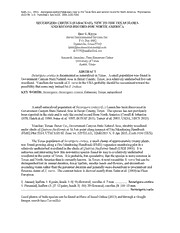
Securigera cretica (Fabaceae), new to the Texas flora and second record for North America PDF
Preview Securigera cretica (Fabaceae), new to the Texas flora and second record for North America
Keith, E.L. 2013. Secuhgera c/-e&Cc3 (Fabaceae), new to the Texas flora and second record for North America. Phytoneuron 2013-39: 1-3. Published 1 July 2013. ISSN 2153 733X NEW SECURIGERA CRETICA (FABACEAE), TO THE TEXAS FLORA AND SECOND RECORD FOR NORTH AMERICA Eric Keith L. Raven Environmental Services Inc. P.O. Box 6482 Texas77342 Huntsville, com ]ieith@ravenenvironm ental. el£7275@suddenlinl£.net Research Associate, Plant Resources Center University of Texas Austin, Texas ABSTRACT A Securigera cretica documented as naturalized in Texas. small population was found in is Government Canyon State Natural Area in Bexar County, Texas, in a relatively undisturbed live oak USA woodland. Vouchers for records of S. varia in the probably should be reexamined toward the some may be possibility that instead S. cretica. KEY WORDS: Securigera, Securigera cretica, Fabaceae, Texas, naturalized A small naturalized population of Securigera cretica (L.) Lassen has been discovered in Government Canyon State Natural Area in Bexar County, Texas. The species has not previously & been reported in the state and only the second record from North America (Correll Johnston is BONAP USDA, NRCS 1970; Hatch et al. 1990; Jones et al. 1997; 2011; Turner et al. 2003; 2013). Voucher: Texas. Bexar Co., Government Canyon State Natural Area, shrubby woodland under shade of Quercus fusiformis at 16.5-m point along transect of Fire Monitoring Handbook UTM NAD (FMH) Plot 5214, 83 Zone 14, 523733.6 E, 32683293 N, 9 Apr 2013, Keith 1034 (TEX). The Texas population of Securigera cretica, a small clump of approximately twenty plants, was found growing along a Fire Monitoring Handbook (FMH) vegetation monitoring plot in a relatively undisturbed woodland in the shade of Quercus fusiformis Small (USDI 2003). It is unknown and interesting how this non-native species found its way to a relatively undisturbed woodland in the center of Texas. It is probable, but speculative, that the species is more common in Texas and North America than is currently known. In Texas, it most resembles S. varia but can be distinguished but its aimual duration, fewer leaflets, smaller heads and flowers, and decumbent- ascending stems rather than the pereimial duration and generally more decumbent to procumbent and flexuous stems of S. varia. The contrast below is derived mostly from Tutin et al. (1968) in Flora mm 3-8 4-7 Aimual; leaflets pairs; heads 3-6(-9)-flowered; corollas Securigera cretica 1. mm Perennial; leaflets (5-)7-12 pairs; heads 5(-10)-20-flowered; corollas (8-)10-15 1. Securigera varia Good photos of both species can be found at Flora of Israel Online (2013) and through a Google Images search (use Coronilla). Keith: Secuhgera cretfcan&N to Texas 2 Securigera cretica native to central and southeastern Europe and Mediterranean Region is tlie including Crete, from where the species was described (Tutin et al. 1968). It has previously been (BONAP USD NRCS reported from only one other location in North America, Maryland 20 A, 1 1; 2013), where was collected in 1954 on chrome ore piles in Canton (Reed 1964). it Lassen (1989) combined eleven species into Securigera from the previously described genera Coronilla L. and Artrolobium Desv., increasing the number of species in the genus to twelve. All twelve of these species are native to the Old World (Tutin et al. 1968; Lassen 1989). Four of these USA twelve species have been reported in the as naturalized or waifs, including Securigera cretica, S. & Deg S (BONAP globosa (Lam.) Lassen, S. securidaca (L.) O. Dorf., and varia (L.) Lassen 2011; USDA, NRCS S S 2013). Isely (1998) had recognized only varia as naturalized and securidaca as a waif. ACKNOWLEDGEMENTS The work that led to this discovery was funded in part through a wildlife grant from U.S. Fish and Wildlife Service and was provided by the Natural Resources Program of the Texas Parks and Wildlife Department (TPWD) in a contract with Raven Environmental Services Inc. David Riskind (TPWD (TPWD Natural Resources Director), Jeff Sparks State Wildland Fire Coordinator), Mike (TPWD Lloyd (State Parks Wildland Fire Management Specialist), and Greg Creacy Natural Resources Coordinator) provided agency oversight of the project. would like to thank Bill Carr of I Acme Tom Wendt Botanical Services for recognizing photos of the plant as a species of Securigera, Guy Nesom (Curator, Univ. of Texas Plant Resources Center) for acquiring literature, and for review and editing. LITERATURE CITED BONAP. 2011 (last update). North American Plant Atlas (US county-level species maps). Maps generated from J.T. Kartesz. Floristic Synthesis of North America, Version 1.0. Biota of North America Program, (in press), <http://www.bonap.org/genera-list.html> Correll, D.S. and M.C. Johnston. 1970. Manual of the Vascular Plants of Texas. Texas Research Foundation, Renner. A Diamond, D.D., D.H. Riskind, and S.L. Orzell. 1987. framework for plant community classification in Texas. Texas I Sci. 39: 203-222. Flora of Israel Online. 2013. The Hebrew University of Jerusalem. <http://flora.huji.ac.il/browse.asp?lang=en&action=specie&specie=SECCRE&fileid=2> Brown MP- Hatch, S.L., K.N. Gandhi, and L.E. 1990. Checklist of the Vascular Plants of Texas. 1655. Texas Agric. Exp. Sta., College Station. Isely, D. 1998. Native and Naturalized Leguminosae (Fabaceae) of the United States (Exclusive of Alaska and Hawaii). Monte L. Bean Life Science Museum. Brigham Young Univ., Provo Utah. A Jones, S.D., J.K. Wipff, and P.M. Montgomery. 1997. Vascular plants of Texas. comprehensive checklist including synonymy, bibliography, and index. Univ. of Texas Press. Austin. A new Lassen, P. 1989. delimitation of genera Coronilla, Hippocrepis and Securigera (Fabaceae). WiUdenowia 49-62. 19: A Reed, C.R. 1964. flora of the chrome and manganese ore piles at Canton, in the Port of Baltimore, Maryland and at Newport News, Virginia, with descriptions. Phytologia 10: 321^06. Turner, B.L., H. Nichols, G. Denny, and O. Doron. 2003. Atlas of the Vascular Plants of Texas. Vol. Bot 2. Sida, Misc. 24. Bot. Res. Inst, of Texas, Fort Worth. N.A D.A Tutin, T.G., V.H. Heywood, Burges, D.M. Moore, D.H. Valentine, S.M. Walters, and Webb. 1968. Flora Europaea Vol. 2, Rosaceae to Umbelliferae. Cambridge Univ. Press, Cambridge England.
